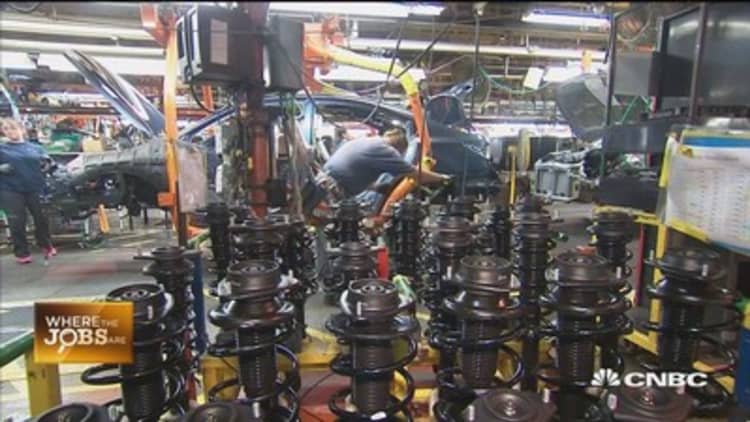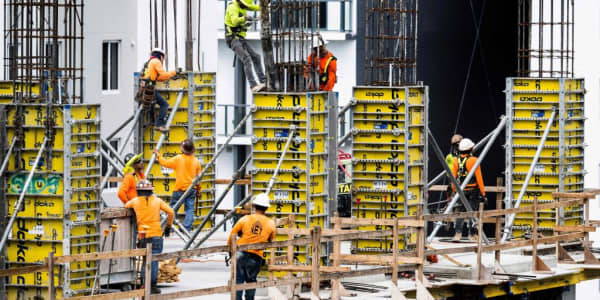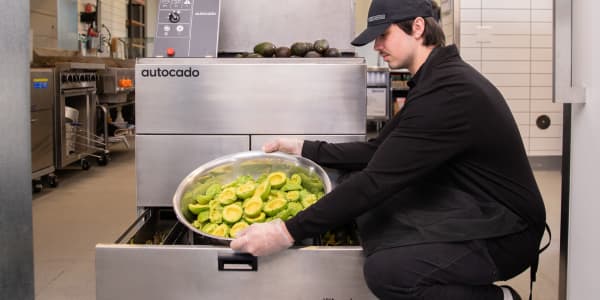
Donald Trump campaigned as a jobs creator, with lofty promises of reviving American manufacturing and reclaiming jobs that had gone overseas. On a campaign stop in 2015, he proclaimed he would "be the greatest jobs president that God ever created."
According to the Bureau of Labor Statistics, an average of about 171,000 jobs were added per month in 2017. While that's a drop from the average of 186,000 jobs added per month in 2016, the last year of Barack Obama's presidency, average unemployment stood at 4.1 percent in December, and it's much lower in pockets of the country.
Such a tight labor market makes finding skilled workers tougher in certain industries. One year into Trump's presidency, Indiana is feeling that job-market pinch, especially in manufacturing.
One in 5 workers in the state holds manufacturing jobs, says Brian Burton, CEO of the Indiana Manufacturers Association.
"We've had a record number of job announcements over the last 12 months, which also creates another problem for us — we have a skills issue — those that need the skills for today's automatic and technologically advanced manufacturing process," Burton said.
The state also faces a population issue, Burton said, with projected growth through 2040 of just 1 percent, far shy of the national average of nearly 20 percent. Retirements from manufacturing are compounding the problem.
The association has even proposed the idea of creating financial incentives to lure workers to the state to fill vacancies in the industry — something Burton is hopeful state lawmakers will consider in the New Year.
"We need to develop incentives for people to come to the state and take advantage of the opportunities we have here," he said. "We're putting forth a tax incentive for individuals, so those who come from out of state would have an elimination of their state income tax for a certain period of time."
The world's largest mining and steelmaking company, ArcelorMittal, hired 640 employees in the U.S. last year and is now heavily recruiting in the Hoosier State. The company is seeking to hire more than 1,000 workers to fill both hourly and salaried positions this year, and many of those jobs are in Indiana. The company, which employs some 18,000 people in the U.S., wants to hire talent in engineering, technical and supply chain roles, as well as human resources.
Year one under Trump has been good for business because of fair trade policies, according to ArcelorMittal Vice President Keith Howell. A potential infrastructure package and a tax code overhaul on the horizon will be positives for the company in 2018.
"Using domestic products and rebuilding our country's roads and bridges would be very positive for manufacturing in general, and also for the steel industry," Howell said.
The top five sectors since the election in terms of the number of jobs added are professional and business services; education and health; leisure and hospitality; construction; and manufacturing. The gains in manufacturing — a total of 214,000 jobs added since December 2016 — have created a new problem for companies trying to fill vacant positions.
To combat a skilled labor shortage stemming from retirements, ArcelorMittal is recruiting candidates from middle and high schools with its Steelworker for the Future Program, launched in 2008. It's intended to reach students who excel in science, technology, engineering and math and for those who enjoy working with their hands and did not intend to enroll in a traditional four-year program.
Dantrell Brooks, 21, was recruited while in high school and applied for the program, which includes assistance with college education and a paid internship at ArcelorMittal. Since 2010, 90 students like Brooks have graduated from the program and have been offered full-time positions at the company, and 144 are enrolled in the program's curriculum at partner schools in Indiana, Illinois, Ohio and West Virginia.
"My senior year of high school, everybody's talking about big name college universities, going there for four years-plus to get a degree," Brooks said. "I saw ArcelorMIttal as a 2½-year degree, less than half the time, guaranteed job, training, craft — I knew I had to go for it."
Economists credit Trump's push for deregulation and the recent victory in overhauling the tax code, both of which sent the stock market and business confidence soaring, for spurring job creation. A rebound in oil prices, a weaker dollar and stronger global economic growth also served as main drivers in job growth.
"The president has a done a good job of creating an economic environment that has been positive for job growth," said Craig Dismuke, chief economist at Vining Sparks. "But I suspect any candidate that was elected on a deregulation and tax cut platform would have seen similar results."
—This article was updated to include December data from the Bureau of Labor Statistics.





